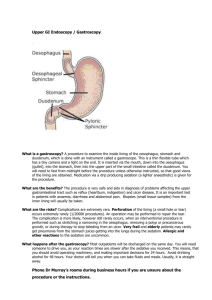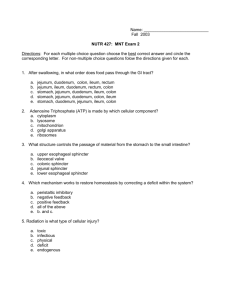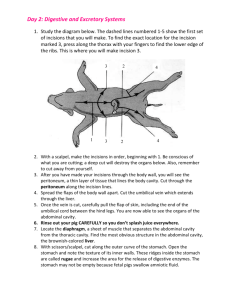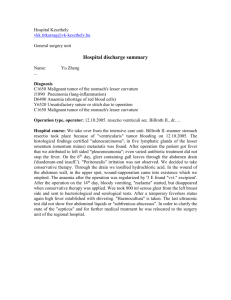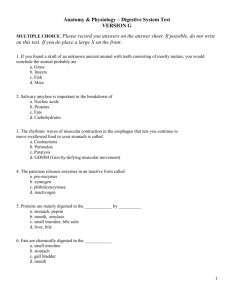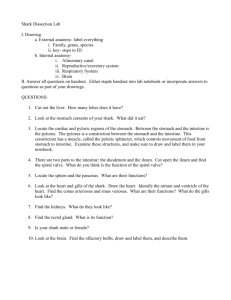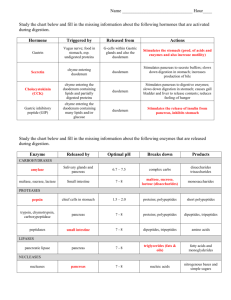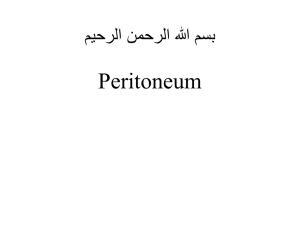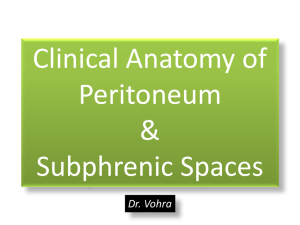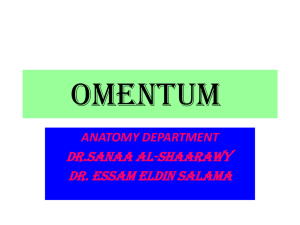Functional Human Morphology (2040) & Functional Anatomy of the
advertisement
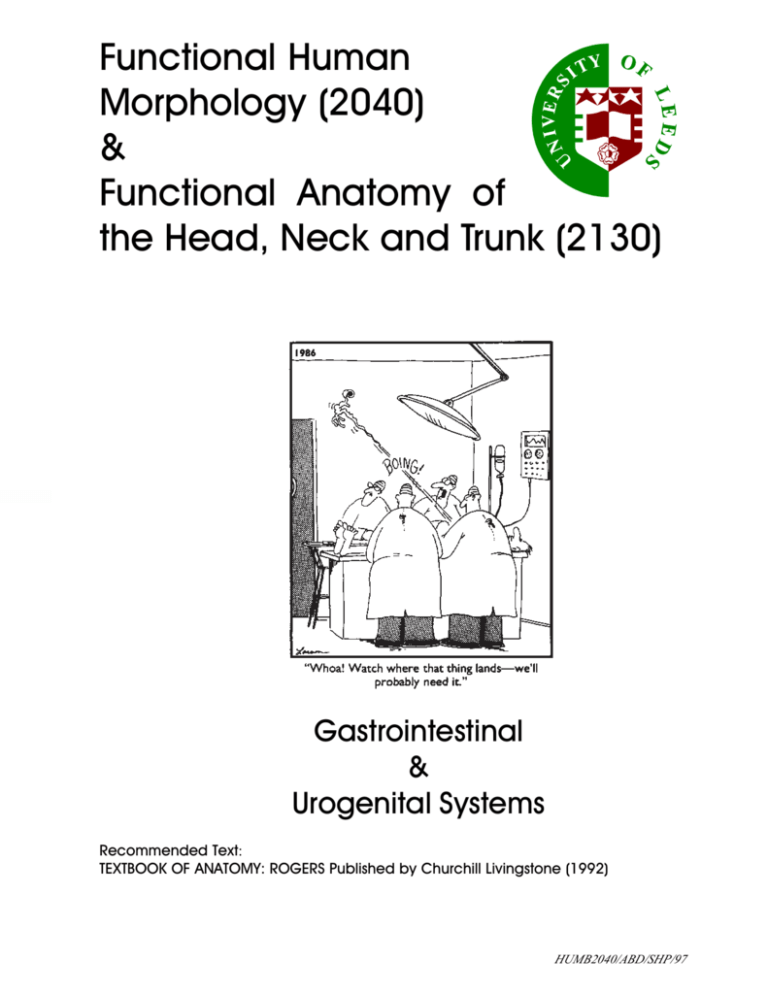
Functional Human Morphology (2040) & Functional Anatomy of the Head, Neck and Trunk (2130) Gastrointestinal & Urogenital Systems Recommended Text: TEXTBOOK OF ANATOMY: ROGERS Published by Churchill Livingstone (1992) 1 HUMB2040/ABD/SHP/97 2 Practical class 1 GASTR OINTESTIN AL TRA CT GASTROINTESTIN OINTESTINAL TRACT OBJECTIVES 1. Outline the support provided by the bones, muscles and fasciae of the abdomen and pelvis which contribute to the support and protection of the gastrointestinal tract. 2. Define the parietal and visceral peritoneum and know which organs are suspended within the peritoneum and which are retroperitoneal. 3. Understand the arrangement of the mesenteries and ligaments through which vessels and nerves reach the organs. 4. Outline the gross structures, anatomical relations and functional significance of the major functional divisions of the gastrointestinal tract. Background reading Rogers: Chapter 16: The muscles and movements of the trunk 29: The peritoneal cavity 30: Oesophagus and Stomach 31: Small and large intestines 3 HUMB2040/ABD/SHP/97 4 Abdominopelvic regions The abdominopelvic cavity extends from the inferior surface of the diaphragm to the superior surface of the pelvic floor (levator ani), and contains the majority of the gastrointestinal tract from the terminal portion of the oesophagus to the middle third of the rectum. Its contents are protected from injury by three structures: the lower bony and cartilagineous ribs (which will be covered in the next part of the course), the muscles of the lateral and anterior abdominal body wall and the bony pelvis. The pelvis serves to (a) surround and protect the pelvic contents, such as the lower portion of the gastrointestinal tract and urogenital organs, (b) provide areas for muscle attachments, and (c) transfer the weight of the trunk to the lower extremities. Each innominate bone arises from the fusion of three individual pairs of bones: ilium ilium, ischium and pubis pubis. Label these on the following diagram . Identify the following bony landmarks on the pelvis, and label them on the following diagram: sacroiliac joint anterior superior iliac spine pubic symphysis pelvic brim coccyx iliac crest obturator foramen ischial tuberosity sacrum 5 HUMB2040/ABD/SHP/97 Which muscles contribute to the anterior body wall? Sketch them on the following lateral view of the trunk. Which muscles contribute to the posterior abdominal wall? Sketch them on the following posterior view of the trunk. Lateral Posterior Peritoneum This is a serous membrane which lines the abdominopelvic cavity, and can be likened to a slack balloon into which the organs are invaginated. The parietal peritoneum lines the abdominal and part of the pelvic walls, while the visceral peritoneum covers the viscera: a film of fluid lubricates the surfaces of the peritoneum and facilitates free movement of the viscera, one against another or against the abdominal or pelvic walls. What is the nerve supply to the peritoneum? Is the visceral peritoneum sensitive to pain? 6 The peritoneum surrounds and supports the viscera in a number of different ways, which may be characterised as follows: A mesentery is a double layer of peritoneal reflection which extends from the abdominal wall to the mobile viscera. A ligament is a double fold of peritoneum extending between two visceral organs. An omentum is a highly modified ligament associated with the stomach. Look at the greater omentum on the prosection and examine its relations with other abdominal viscera, especially the stomach and the transverse colon. Between what parts of which two organs does the greater omentum extend? Why do surgeons sometimes call the greater omentum the 'abdominal policeman'? Look at the lesser omentum on the prosection and note that it extends from the porta hepatis of the liver to the lesser curvature of the stomach and first part of the duodenum. It contains in its free edge; the portal vein vein, hepatic artery and common bile duct duct, and adjacent to the lesser curvature of the stomach the left and right gastric vessels. Consider where and in what direction these vessels are running. Introduce a finger under the right free margin of the lesser omentum and locate the epiploic foramen of Winslow omental bursa Winslow) which leads into the lesser sac (omental bursa). foramen (foramen Consider the drainage of fluid from the lesser sac, why might infection be prolonged in this area compared to others? The peritoneal cavity can be divided into two quite separate regions connected only by the epiploic foramen. The lesser sac is an irregular space lying behind the liver, lesser omentum, stomach and upper anterior part of the greater omentum. The greater sac is the remainder of the peritoneal cavity running from the diaphragm to the pelvic floor. What is peritonitis? What are its most common causes? 7 HUMB2040/ABD/SHP/97 Using the following diagrams, shade the areas occupied by the lesser and greater sacs and label the following structures. Lienorenal ligament Gastrosplenic ligament Falciform ligament Epiploic foramen Greater sac Rectouterine space Vesicouterine space Hepatorenal recess Subphrenic recess Lesser sac 8 The following diagram shows the posterior abdominal wall with the mobile viscera removed. The cut edges of the peritoneal reflections (ligaments and mesenteries) on to the abdominal walls are shown through the parietal peritoneum. Label the retroperitoneal organs indicated on the following diagram. It is important that you appreciate the arrangement of the peritoneum. GASTROINTESTINAL VISCERA Oesophagus We will now consider the oesophagus which connects the pharynx in the neck to the stomach in the abdomen. It begins at the pharyngo-oesophageal junction and runs down behind the trachea to the level of T4, it then moves slightly to the left and pierces the diaphragm at the level of T10. Between T4 and T10 it becomes surrounded by the oesophageal plexus of the vagus nerves which regroup into anterior and posterior vagi (or gastric nerves nerves). Below the diaphragm the oesophagus enters the abdominopelvic cavity turns even more to the left running for 2cm before entering the stomach at the gastro-oesophageal junction. Look at the prosection and establish its relation with the left primary bronchus, arch of the aorta, left vagus and left phrenic nerves. 9 HUMB2040/ABD/SHP/97 Where do the oesophageal sphincters lie, and what is the clinical significance, in particular, of the lower oesophageal sphincter? What is the blood supply to the oesophagus? What is the lymphatic drainage of the oesophagus? We will now consider the major part of the gastrointestinal tract which lies within the abdominopelvic cavity. Examine the isolated organs on display. Consider their size, shape and position in the abdomen. Identify the following major anatomical subdivisions: stomach liver and gall bladder duodenum pancreas jejunum and ileum caecum and appendix ascending, transverse, descending and sigmoid colon rectum Stomach The stomach is a j-shaped muscular bag located in the left hypochondriac and epigastric regions of the abdomen, communicating with the oesophagus via the cardiac orifice and continuing into the duodenum via the pyloric orifice orifice. What three muscle layers constitute the stomach wall? On the prosections available identify the following features of the stomach: Greater and lesser curvature; anterior and posterior walls; cardiac and pyloric notches. Cardium, fundus, body and pylorus, the latter is further subdivided into pyloric antrum and canal. Rugae (conspicuous in a contracted specimen). 10 Label as many of these as possible on the following diagram. Appreciate that the position and relations of the stomach to its surroundings changes according to the posture assumed, individual build and fullness of its contents etc. On the prosected specimen trace the relations of the stomach. List some of these in the space below. What are the major functions of the stomach? How is it structurally specialised to carry these out? 11 HUMB2040/ABD/SHP/97 Small intestine The next portion of the gastrointestinal tact; the small intestine, is the major site for digestion and absorption, and is divided into three parts each with slightly different structural and functional characteristics. DUODENUM Look at the prosections of the duodenumon display. Using the following diagram verify its shape, other identifying features and relations as follows: a) The duodenum is a short C-shaped tube surrounding the head of the pancreas. b) It has a mobile peritoneal section at the beginning of the first part (this is known as the duodenal cap on a radiograph) into which the pylorus of the stomach leads, c) the rest of the duodenum is retroperitoneal. Identify the 2nd, 3rd and 4th parts and appreciate the directions of flow of its contents. d) On the medial border of the 2nd part of the duodenum identify the major papilla papilla, through which bile (stored in the gall bladder) and pancreatic enzymes (derived from the exocrine pancreas) enter the small intestine through a duct system called the extrahepatic biliary apparatus apparatus. On the following diagram, name the four parts of the duodenum, and shade which parts are retroperitoneal. Between what vertebral levels is the duodenum found? The secretions of which glands empty into the lumen of the duodenum? 12 Complete the following table to indicate the relations of the duodenum. Anterior Gall bladder and quadrate lobe of liver 1st part Renal a 2nd part 3rd part Superior mesenteric artery and vein 4th part Mesentery Inferior inferior What are the functions of the duodenum? JEJUNUM AND ILEUM The jejunum makes up the proximal two-fifths of the small intestine while the ileum comprises the distal three-fifths, but there is no macroscopic demarcation between the two. Examine the isolated specimen as well as the prosections of the abdomen. A gradual change in character is noticeable from proximal to distal direction of the bowel. Consider the following diagram and table, ensure that you can appreciate the differences between ileum and jejunum in the prosected specimens. Jejunum Ileum Note that the jejunum and ileum are suspended by a huge fold of mesentery from the posterior body wall. 13 HUMB2040/ABD/SHP/97 Wall Lumen Plicae circulares Jejunum Thick Small Present Ileum Thin Large Absent What function do Peyer’s patches serve? What are the functions of the jejunum and ileum? How are they specialised to carry out these functions? Large intestine The small intestine leads into the large intestine. The latter begins at the ileocaecal junction extends to the anus: it consists of caecum, appendix, colon, rectum and anal canal canal. CAECUM This is a fully peritonised U-shaped blind pouch situated in the right iliac fossa. Find the caecum, the ileocaecal junction and the peritoneal folds of the region. APPENDIX This is a narrow hollow blind-ended muscular tube of variable length. It is suspended from the terminal ileum by a small mesentery - the mesoappendix that contains the appendicular vessels vessels. Look for the appendix at the posteromedial wall of the caecum, below the ileocaecal junction (however, its position may vary). What is McBurney’s point? 14 COLON The colon has four parts; ascending and descending parts of the colon are retroperitoneal but the transverse and sigmoid parts are each suspended by their own mesentery. What are they called? Macroscopically the colon can easily be distinguished from the small bowel by the following: a) the calibre is greater in the large bowel. b) the outer longitudinal muscle layer is divided into 3 strap-like muscles called the taeniae coli coli. c) between the above muscle band sacculation - known as haustra occur. d) epiploic appendages or fatty tags are present along its length. Locate these structures on the prosections available, and confirm that the vermiform appendix lies at the proximal end of one of the three taeniae coli coli. Look at the entire length of the colon and identify its four parts, noting its relations with the small bowel, kidneys, liver, stomach, pancreas, spleen and major vessels. What are the functions of the colon? How is it specialised to carry these out? Rectum Following the curvature of the sacrum and coccyx, the rectum extends from the sigmoid colon to the anal canal. Look at the prosection of rectum in situ and note that: a) on its proximal third, the anterior, right and left aspects are covered by the peritoneum; b) on the middle third, only the anterior surface is covered; and c) on the distal third, there is no peritoneal covering at all. What is the puborectal sling? What change of direction does the puborectal sling create in the path of the faeces being voided? 15 HUMB2040/ABD/SHP/97 Examine an isolated specimen and note that its mucous membrane together with the circular muscle layer form three permanent transverse folds known as the valves of Houston Houston. Anal canal The anal canal runs below the pelvic diaphragm and ends at the anal orifice. It is surrounded by internal and external anal sphincter and supported by the levator ani muscle. It has two parts; the upper two-thirds belongs to the intestine and is called the visceral portion and a lower third belongs to the perineum and is called the somatic portion portion. The latter has its own vascular and nerve supply. Study the following diagram, and complete the labelling. Not all the features described in the diagram may be obvious in the fixed specimen, however you should try to locate them. In its upper half there are 5-10 permanent longitudinal folds of mucosa - the anal columns columns, interspersed by furrows. Crescent-shaped mucosal folds called the anal valves connect the lower ends of the anal columns. A line called the pectinate line crosses the bases of the anal columns and demarcates the visceral portion above from the somatic portion below. The anal epithelium is surrounded by internal and external anal sphincters. The internal sphincter is a thickened extension of inner circular layer of smooth muscle of rectum. The external anal sphincter has a deep deep, superficial and subcutaneous parts. The anorectal ring ring, consisting of the external sphincter, the internal sphincter and part of the levator ani muscle, is the most important part of the sphincteric mechanism of the anal canal. What is its clinical significance? Review the gastrointestinal tract, and ensure that you can address the objectives set out at the beginning of the section. 16
